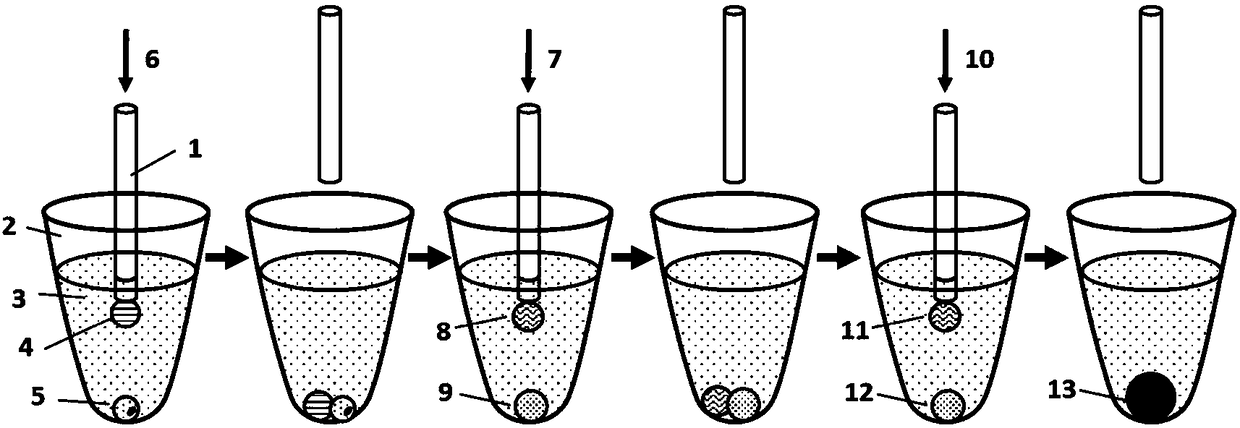Micro-volume cell nucleic acid amplification method
A cell nucleic acid, micro-volume technology, applied in biochemical equipment and methods, microbial determination/inspection, etc., can solve problems such as being unsuitable for popularization, low throughput, and inability to be popularized
- Summary
- Abstract
- Description
- Claims
- Application Information
AI Technical Summary
Problems solved by technology
Method used
Image
Examples
Embodiment 1
[0046] figure 1 Among them, the inner diameter of the quartz capillary 1 is 50 microns, the outer diameter is 150 microns, and the length is 5 cm. The upper end of the quartz capillary 1 is connected with a syringe pump (Harvard Apparatus, Pico Elite, not in figure 1 Shown in ) connection, the connection gap is sealed with wax to ensure airtightness. The syringe pump is equipped with a syringe with a volume of 10 microliters. Before use, fill the syringe with mineral oil, Teflon capillary and quartz capillary1 filled with cell lysate, and check the liquid flow path for no leaks. The small container 2 is a centrifuge tube in a U-shaped bottom 96-well plate with a maximum capacity of 200 microliters. The volume of the mineral oil 3 is 40 microliters. Droplets enclose single cells to be analyzed.
[0047] Insert the quartz capillary 1 vertically 5 mm below the liquid surface of the mineral oil 3 and keep it still. Inject 30 nanoliters of lysate with a syringe pump. After the ...
Embodiment 2
[0050] To demonstrate the precision of the microinjection employed by the present invention, we tested the reliability of using a microsyringe pump to inject 1 to 100 nanoliter volume droplets of the aqueous phase into the oil phase. Such as figure 2 , according to the microinjection filling method of Example 1, at the bottom of a small container filled with mineral oil in advance, micro-droplets with le different nanoliter level volumes were obtained. 1 is 1 nanoliter, 2 is 5 nanoliters, 3 is 10 nanoliters, 4 is 20 nanoliters, 5 is 50 nanoliters, and 6 is 100 nanoliters. Correspondingly, the flow rate of the syringe pump is 1 nL / s, 5 nL / s, 10 nL / s, 20 nL / s, 50 nL / s, 100 nL / s. Scale bar is 200 microns.
Embodiment 3
[0052] In order to demonstrate the reliability of the centrifugal microdroplet fusion adopted in the present invention, as image 3 According to the micro-droplet filling method in Example 1, two micro-droplets of 5 nanoliters were sequentially generated at the bottom of the same container. The content of droplet 1 is 0.1M FeCl 3 Solution, the content of micro-droplet 2 is 0.1M KSCN solution, two micro-droplets meet and merge to form micro-droplet 3, the contents are mixed, and the two solutions react to form reddish-brown Fe(SCN) 3 solution. Scale bar is 200 microns.
PUM
| Property | Measurement | Unit |
|---|---|---|
| length | aaaaa | aaaaa |
Abstract
Description
Claims
Application Information
 Login to View More
Login to View More - Generate Ideas
- Intellectual Property
- Life Sciences
- Materials
- Tech Scout
- Unparalleled Data Quality
- Higher Quality Content
- 60% Fewer Hallucinations
Browse by: Latest US Patents, China's latest patents, Technical Efficacy Thesaurus, Application Domain, Technology Topic, Popular Technical Reports.
© 2025 PatSnap. All rights reserved.Legal|Privacy policy|Modern Slavery Act Transparency Statement|Sitemap|About US| Contact US: help@patsnap.com



